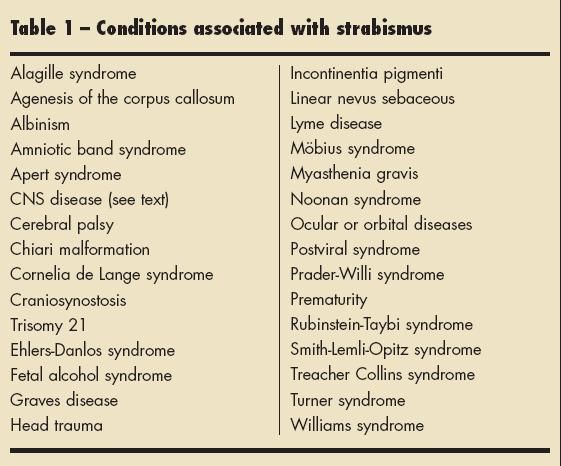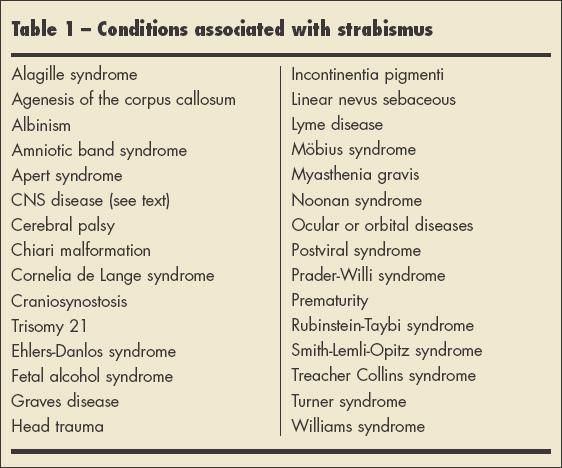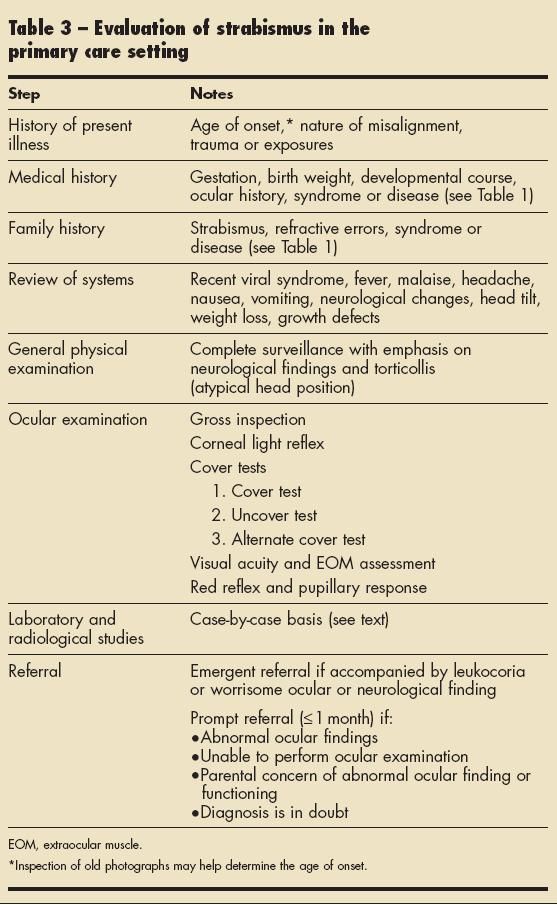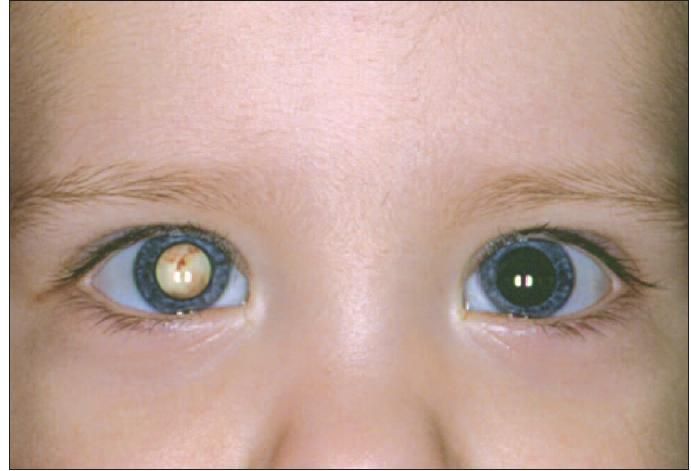Strabismus:
Routine screening for eye disease at all well-child visits should begin in the newborn period. Prompt ophthalmological referral of patients with strabismus or any suspected eye disease is essential to determine the underlying cause, optimize treatment, and preserve binocular vision
Strabismus (ocular misalignment) can lead to amblyopia and permanent vision loss. Amblyopia-poor vision in an otherwise normal eye-is best addressed in the preschool years; if this condition is left untreated, irreversible visual loss may ensue. Strabismus is sometimes indicative of or associated with a more serious condition (Table 1).

Table 1
Parents commonly discover strabismus. In one study, strabismus or leukocoria as the presenting symptom of retinoblastoma was discovered by a family member in 75% of cases.1 But not all ocular disease is recognized at home. Screening for ocular disease at each well-child visit ensures that prompt referral to an ophthalmologist, preferably a pediatric ophthalmologist, can be made. Early detection and diagnosis of ocular defects can prevent vision loss, facilitate the treatment of associated life-threatening conditions, and ameliorate any adverse emotional effects.
Children do not "outgrow" strabismus, and its psychological impact must not be overlooked. Strabismus can have an adverse effect on the psychological well-being of children.2 In addition, adults with strabismus experience more general anxiety, social anxiety, and social avoidance than those in the general population.3 Psychosocial adjustment improves after surgical correction.
The 3 screening methods needed to detect strabismus are:
- Gross inspection.
- Light reflex tests, including the Bruckner test (inspection for a red reflex).
- Cover tests.
In the general pediatric clinic, ophthalmoscopy and measurement of visual acuity are also crucial.
In this article, we review the basics of the eye examination and provide an overview of the strabismus evaluation in the primary care setting.
EPIDEMIOLOGY
Amblyopia is the most common cause of visual impairment in children, 4 and strabismus is one of the major causes of amblyopia. In a multiethnic study of pediatric eye disease, the prevalence of strabismus ranged from 1.2% to 5.6%.5 In another study, Ip and colleagues6 examined 6-year-old children with and without eye-strain symptoms (double or blurred vision, sore eyes, headaches associated with work requiring near-vision); strabismus was found in 7.3% and 1.8%, respectively. Typically, children with strabismus and/or amblyopia have no symptoms.
Horizontal ocular deviations occur much more frequently than vertical deviations. The deviations can be labeled "tropia" (constant or manifest deviation) or "phoria" (latent deviation, which reveals itself only when binocular vision is interrupted). In particular, esotropia (eye rotated in so the cornea is deviated nasally) occurs about twice as often than exotropia (eye rotated out temporally)7 and is more likely to lead to amblyopia.8
Vertical strabismus, hypertropia or hypotropia (eye rotated so that the cornea is deviated superiorly or inferiorly) is less common. In a study of vertical strabismus (hypertropia or ocular up-turning specifically), Tollefson and associates9 reported a prevalence of 0.26%.
Keep in mind that strabismus seldom exists in isolation. In one study, strabismus was significantly associated with other ophthalmological abnormalities, such as amblyopia, hyperopia (hypermetropia or far-sightedness), astigmatism, and anisometropia (unequal refractive error in both eyes).7 These associations further emphasize the need to refer children with strabismus to an ophthalmologist for a more in-depth ocular evaluation.
ETIOLOGY AND PATHOGENESIS
Normal ocular alignment and movement depends on the normal development, functioning, and interplay of several structures (eye, orbit, extraocular muscles, cranial nerves [CN], cerebrum, cerebellum, vestibular nuclei, ocular motor nuclei, and brain stem). Maturation of the visual system progresses by 2 to 4 months of age so that intermittent ocular deviation (neonatal strabismus) ceases. If intermittent ocular misalignment persists beyond this time or if constant deviation is evident before then, referral to the ophthalmologist is necessary.10,11
Pathological ocular deviations can result from congenital or acquired abnormalities that arise in any of the involved structures and pathways of the visual system. Associated signs and symptoms and physical examination findings provide clues to the location of the lesion causing the abnormal eye movements. Strabismus may be comitant or incomitant: this distinction is important because the causes of the 2 types can differ.
Comitant strabismus refers to misalignment characterized by ocular deviation that remains constant in all directions of gaze. The child with comitant strabismus has normal extraocular muscles, but the eyes are not focused on the same end point when binocular vision is attempted. Two well-studied types of comitant strabismus include congenital esotropia (also known as essential infantile esotropia, idiopathic infantile esotropia, or essential esotropia) and accommodative esotropia (AE).
The exact cause of congenital esotropia is unknown, but genetics plays an important role in its development.12 Although named "congenital" esotropia, this entity does not usually reveal itself until a child is a few months old but before the age of 6 months. A constant, large-angled deviation characterizes this type of strabismus in an otherwise healthy child.
AE presents after the age of 6 months and often in toddlers (aged 2 to 3 years). There are 3 categories of AE:
- Refractive (can be eliminated by wearing spectacles).
- Nonrefractive.
- Partial or decompensated (wearing glasses can reduce but not eliminate the condition).
The history often includes the presence of an initially intermittent, smaller esotropia that may have become constant. Hypermetropia is a risk factor for esotropia because the hyperopic eye tries to focus by accommodation, which results in excessive convergence.13 Basic acquired esotropia that is non-accommodative is unusual in childhood.
Common forms of childhood exotropia include intermittent exotropia and exotropia associated with congenital abnormalities, such as cerebral palsy and Down syndrome.14 Vertical strabismus may occur secondary to "overaction" or "underaction" of the oblique muscles.
Inheritance patterns of the common forms of strabismus are complex and not fully defined.15 Along with family history, refractive errors, cerebral palsy, prematurity, retinopathy of prematurity, and genetic syndromes, 16 other reported risk factors for comitant strabismus include race (ie, the majority of persons with esotropia are white whereas exotropia is more common in Asians) and low birth weight.12
Incomitant strabismus refers to ocular deviation that does not remain constant in all directions of gaze. The condition is caused by orbital, muscular, or CNS disturbances. Although central neurological disturbances (ie, tumor, increased intracranial pressure, aneurysm, hemorrhage, infection, inflammation, thrombosis, vascular malformation, and trauma) typically lead to strabismus that is incomitant, comitant strabismus may also occur from entities such as a brain stem glioma17 or cerebellar astrocytoma.18
Primary eye or orbital defects can lead to a specific type of incomitant strabismus known as sensory strabismus. This occurs because the vision is so poor in one eye that binocular vision is no longer attempted, and the abnormal eye drifts.
Retinoblastoma, for instance, can cause incomitant, sensory strabismus. Strabismus, along with leukocoria, is a major presenting symptom of retinoblastoma. Rodrigues and colleagues19 found that the presence of strabismus was associated with a longer lag time to diagnosis and worse prognosis for patients with retinoblastoma. In contrast, Abramson and colleagues20 reported high patient survival but poor ocular survival among retinoblastoma patients who presented with strabismus; ocular survival was better in those in whom leukocoria was the presenting sign. Other ocular defects, such as cataract, retinopathy of prematurity, and optic nerve hypoplasia, can also lead to sensory strabismus.21
Paralytic and restrictive strabismus are types of incomitant strabismus that mainly result from paralysis or restriction of the nerves and muscles involved in normal ocular alignment and movement. The 3 CN and 6 extraocular (rectus and oblique) muscles each have a role in maintaining ocular alignment and facilitating ocular movement (Table 2). The muscles work together in a specific synergistic and opposing manner so that during binocular viewing (or versions), contraction of an extraocular muscle in one eye results in the simultaneous contraction of its agonist muscle in the other eye. (This phenomenon is known as Hering's Law.22) With monocular viewing (or ductions), contraction of an extraocular muscle is accompanied by relaxation of its antagonist muscle in the same eye. (This is known as Sherrington's Law.22) Abnormal processes that violate these laws produce incomitant strabismus.

Table 2
Congenital or acquired palsies of CN III, IV, and VI are the major causes of paralytic strabismus. Ocular deviation occurs secondary to disrupted innervation of the muscle. Acquired palsies may result from serious CNS disturbances (see Table 2), trauma, or a postviral syndrome (which is an exclusionary diagnosis). Acute onset of nerve palsy, especially of CN III, strongly suggests the presence of a CNS abnormality. Ocular, orbital, or head trauma and the resultant inflammation, hemorrhage, or nerve entrapment can result in CN palsies, especially of CN IV because of its long intracranial course. Congenital or acquired CN IV abnormalities may result in hypertropia.
Other causes of hypertropia involve muscle defects. Intramuscular hemangioma of the superior rectus as a cause of hypertropia has been described in an adult patient.23 Brown syndrome, a congenital or acquired restrictive strabismus, is secondary to restriction of the superior oblique tendon, which typically is discovered after infancy. Tollefson and colleagues9 listed Brown syndrome as the third most common cause of vertical strabismus, along with CNS abnormalities and after CN IV palsy and primary inferior oblique overaction. Myositis of the medial or lateral rectus can lead to palsy of these ocular muscles and result in exotropia or esotropia, respectively.24
Mimics of CN VI palsy include orbital lesions and fractures, thyroid disease, myasthenia gravis (rare in children), and Duane syndrome.25 This syndrome has 3 forms, may occur bilaterally, and is secondary to abnormal functioning of CN VI. Retraction of the globe, narrowing of the palpebral fissure during attempted adduction (which is restricted), and absent or restricted abduction are features of Duane syndrome.26 Patients with this syndrome experience simultaneous contraction of the antagonist pair of muscles (medial and lateral rectus) on the affected side, which is a violation of Sherrington's Law.22 Mbius syndrome also involves a congenital defect in the functioning of CN VI and CN VII. Affected patients present with esotropia and an expressionless face.
An uncommon cause of incomitant strabismus is Gradenigo syndrome, which consists of otitis media, facial pain in the distribution of the first and second divisions of CN V, and ipsilateral CN VI palsy.27,28 Inflammation of the petrous apex of the temporal bone and mastoid edema cause the nerve dysfunction. Patients have pain and may present with medial deviation of the eye on the affected side, inability to abduct the affected eye, lethargy, headache, and fever. Lyme disease rarely leads to palsies of the CN (typically of CN VII) in children. However, ocular deviation may occur, as described in an adult with diplopia and palsy of CN VI.29
EVALUATION
Look for clues in the history and physical examination that may point to an underlying systemic or neurological abnormality. Table 3 summarizes the evaluation of strabismus in the primary care setting.

Table 3
History. Inquire about the nature of the abnormal ocular finding (whether intermittent or constant, acute or chronic) and the age of onset and its association with recent head trauma or exposures (ticks, infections, travel). Old photographs may show evidence of ocular deviation and abnormal red reflexes. Ask whether other family members have strabismus, refractive errors, or other associated syndromes or diseases. In the medical history, include details about the perinatal (ie, prematurity, low birth weight) and developmental courses (eg, cerebral palsy) as well as the presence of a known syndrome (eg, Down syndrome).
Obtain a complete review of systems, particularly in the case of new onset incomitant strabismus. Attention must be given to a history of recent viral infections, fever, headache, head tilt, nausea, vomiting, neurological changes, malaise, trauma, weight loss, and growth defects. Older children may be able to describe the sensation of diplopia.
Physical examination. A general survey of the child is necessary, especially in those with acute onset and suspected paralytic or restrictive strabismus. Note any evidence of recent trauma, unusual facial features, or birth defects. Observe the child for constant or intermittent ocular deviation or an obvious or subtle atypical positioning of the head. Head tilting and facial turning, with the chin positioned up or down, and torticollis may be the first clues to many ocular defects, including strabismus.30
Ocular examination. To detect strabismus and other eye diseases, the American Academy of Pediatrics recommends eye examinations at every well-child visit beginning in the newborn period.31 For the child younger than 3 years, the ocular examination includes gross inspection of the eyes and lids to ensure normal pupillary responses and symmetric red reflexes (the Bruckner test) (Figure 1). Age-appropriate visual acuity assessments (ie, Snellen charts in cooperative, capable youngsters) and ophthalmoscopy should also be attempted. The necessity of the strabismus screening tests cannot be over-emphasized; a child cannot be labeled "strabismic" until failure of the strabismus screening tests is documented.

Figure 1 - Inspection for a red reflex (Bruckner test) in this child revealed asymmetry with leukocoria (white pupil) of the right eye secondary to retinoblastoma.
Gross inspection of the eye. To encourage eye opening in a newborn, the examination room should be darkened while the parent lifts the infant upright vertically.32 Gross inspection may reveal a structural eye defect (eg, cataract), ocular deviation, exophthalmus, proptosis, globe retraction, nystagmus, ptosis, epicanthal folds, a wide nasal bridge, or closely or widely spaced eyes. The illusion that a child's eye is in-turning because of a wide nasal bridge, epicanthal folds, or closely spaced eyes is called "pseudostrabismus." Widely spaced eyes can simulate exotropia.
Corneal light reflex test. Also known as the Hirschberg method, the corneal light reflex test is performed by having the child fixate on a light held about 18 to 24 inches in front of the face (Figure 2). The light that reflects back from the eyes should be in the same location on the 2 corneas; temporal displacement suggests esotropia, nasal displacement suggests exotropia, inferior displacement suggests hypertropia, and superior displacement suggests hypotropia.33 Any asymmetry to where the reflected light falls indicates the possibility of misalignment.

Figure 2 - This child has large angle esotropia. Note the asymmetric corneal light reflex (Hirschberg test) at the nasal pupillary margin in the right, fixating eye and near the temporal edge of the iris in the left, deviating eye.
Cover tests. The cover tests involve 3 steps that detect a manifest (tropia) or latent (phoria) deviation. Each step must be repeated for each eye.
- Step 1, the "cover test": cover one eye while the patient views an object positioned 10 feet away.31 During and after placement of the cover, the uncovered eye is observed for any movements that indicate the need to refocus. A nasal movement implies exotropia, temporal movement implies esotropia, upward movement implies hypotropia, and downward movement implies hypertropia.
- Step 2, the "uncover test": cover one eye, but focus the examination on the covered eye once the cover is removed. If the just-uncovered eye moves to regain focus, a phoria or intermittent tropia is present. If the just-uncovered eye is deviated and remains deviated, a tropia is likely.
- Step 3, the "alternate cover test":occlude each eye in an alternating manner. If the affected eye moves in an attempt to regain fixation, a phoria is present.
Visual acuity assessments. Although a precise measurement of visual acuity is impossible in the very young child, the clinician can observe the patient's ability for ocular fixation and pursuit. Fixation refers to the ability to look directly at an object without obvious ocular deviation, and pursuit refers to the ability to fixate on an object and visually follow it through various ranges of eye movements. If the child can be enticed to visually follow an object, extra ocular muscle function can be assessed. Limitations to movement in certain directions suggest paretic eye deviation.
Laboratory and radiological studies
. Unless new onset and/or paralytic strabismus is present and a systemic disorder is suspected, laboratory studies are not a routine part of the evaluation of strabismus in children. If needed, laboratory studies are chosen on a case-by-case basis.
For a child with dysmorphic features, chromosomal analysis may point to a specific genetic syndrome. Thyroid function tests would be helpful in suspected cases of Graves disease. However, because Graves disease is a rare cause of childhood strabismus, it is considered only when other supporting signs and symptoms are present. Screening for Lyme disease may be considered when CN VI or VII palsy is present and the history includes travel to or residence in an area where the disease in endemic.
A complete blood count, blood culture, and cerebrospinal fluid analysis with culture are necessary in suspected cases of meningitis or Gradenigo syndrome. A lumbar puncture may not be performed until a radiological study is obtained to rule out a CNS mass. In complex cases, the pediatric ophthalmologist, and perhaps a pediatric neurologist, should be consulted regarding further testing.
Consider imaging studies in all cases of acutely acquired strabismus, even in comitant strabismus. In a prospective study of acutely acquired comitant esotropia, Lyons and associates34 found that no single clinical sign can reliably indicate the rare patient with a tumor. Strabismus can be the first sign of a CNS tumor in patients who have no other neurological signs or symptoms.18 MRI is the optimal study for detection of most CNS or orbital abnormalities in patients with acute palsies.
In emergent situations, a CT scan with and without contrast would also reveal most mass lesions, infectious or traumatic processes, or vascular accidents. Obviously, the finding of a tumor requires subsequent oncological evaluation and treatment.
Orbital CT scan may reveal bony fractures, inflammatory or infectious orbital processes, or enlarged ocular muscles in cases of orbital myositis.24 Mastoid edema, temporal bone inflammation, and sinus thrombosis are potential findings in the patient with Gradenigo syndrome. 27,28 In some patients, the ophthalmologist may recommend further evaluation of the extraocular muscles. Imaging of extraocular muscles may demonstrate abnormalities in muscle size and location in some patients with strabismus, which may help pinpoint the exact cause of the ocular deviation.35
Referral. The timely referral to an ophthalmologist is paramount.36 Butros and associates1 reported that in some cases of retinoblastoma, ophthalmological referrals were delayed from 3 to 24 months after the patient presented with strabismus. Eye salvage was more likely in bilateral cases when the patient was referred within 0.5 months of presentation of an abnormal eye finding. Reasons for delayed referral included the belief that the child had normal eyes or had another diagnosis.
Refer patients when any parts of the ocular examination are abnormal or when parents report an abnormal eye finding and the child is too difficult to examine. Certainly, an ophthalmological referral is prudent whenever the diagnosis is uncertain.
Definitive diagnosis requires a thorough ophthalmological evaluation, which may include slit lamp and dilated fundoscopic examinations and tests for visual acuity, refractive errors, and ocular deviation through the use of prisms.
The ophthalmologist will determine the optimum treatment based on the type of ocular deviation and its cause. Treatment may include surgery, corrective spectacles, and/or the injection of botulinum toxin.13,37,38 Children with strabismus require the simultaneous and immediate treatment of any amblyopia and ocular misalignment. Treatments for amblyopia are effective and tolerable and should be employed as early as possible.39
References:
- Butros LJ, Abramson DH, Dunkel IJ. Delayed diagnosis of retinoblastoma: analysis of degree, cause, and potential consequences. Pediatrics. 2002;109:45.
- Sabri K, Knapp CM, Thompson JR, Gottlob I. The VF-14 and psychological impact of amblyopia and strabismus. Invest Ophthalmol Vis Sci. 2006;47: 4386-4392.
- Jackson S, Harrad RA, Morris M, Rumsey N. The psychosocial benefits of corrective surgery for adults with strabismus. Br J Ophthalmol. 2006;90: 883-888.
- Robaei D, Huynh SC, Kifley A, Mitchell P. Correctable and non-correctable visual impairment in a population-based sample of 12-year-old Australian children. Am J Ophthalmol. 2006;142:112-118.
- Varma R, Deneen J, Cotter S, et al. The multiethnic pediatric eye disease study: design and methods. Ophthalmic Epidemiol. 2006;13:253-262.
- Ip JM, Robaei D, Rochtchina E, Mitchell P. Prevalence of eye disorders in young children with eyestrain complaints. Am J Ophthalmol. 2006;142: 495-497.
- Robaei D, Rose KA, Kifley A, et al. Factors associated with childhood strabismus: finding from a population-based study. Ophthalmology. 2006;113: 1146-1153.
- Mittelman D. Amblyopia. Pediatr Clin North Am. 2003;50:189-196.
- Tollefson MM, Mohney BG, Diehl NN, Burke JP. Incidence and types of childhood hypertropia: a population-based study. Ophthalmology. 2006;113: 1142-1145.
- Ticho BH. Strabismus. Pediatr Clin North Am. 2003;50:173-188.
- Lavin PJM, Donahue SP. Disorders of supranuclear control of ocular motility. In: Yanoff M, Duker JS, eds. Ophthalmology. 2nd ed. St Louis: Mosby; 2004:1309.
- Michaelides M, Moore AT. The genetics of strabismus. J Med Genet. 2004;41:641-646.
- Liang SL, Fricke TR. Diagnosis and management of accommodative esotropia. Clin Exp Optom. 2006;89:325-331.
- Mohney BG, Huffaker RK. Common forms of childhood exotropia. Ophthalmology. 2003;110: 1093-1096.
- Parikh V, Shugart YY, Doheny KF, et al. A strabismus susceptibility locus on chromosome 7p. Proc Natl Acad Sci U S A. 2003;100:12283-12288.
- Yurdakul NS, Ugurlu S, Maden A. Strabismus in Down syndrome. J Pediatr Ophthalmol Strabismus. 2006;43:27-30.
- Savino G, Colucci D, Rebecchi MT, Dickmann A. Acute onset concomitant esotropia: sensorial evaluation, prism adaptation test, and surgery planning. J Pediatr Ophthalmol Strabismus. 2005;42:342-348.
- Dikici K, Cicik E, Akman C, et al. Cerebellar astrocytoma presenting with acute esotropia in a 5 year-old girl. Case report. Int Ophthalmol. 1999;23: 167-170.
- Rodrigues KE, Latorre Mdo R, de Camargo B. Delayed diagnosis in retinoblastoma. [in Portuguese]. J Pediatr (Rio J). 2004;80:511-516.
- Abramson DH, Beaverson K, Sangani P, et al. Screening for retinoblastoma: presenting signs as prognosticators of patient and ocular survival. Pediatrics. 2003;112:1248-1255.
- Mohney BG. Common forms of childhood esotropia. Ophthalmology. 2002;109:1583-1584.
- Campolattaro BN, Wang FM. Anatomy and physiology of the extraocular muscles and surrounding tissues. In: Yanoff M, Duker JS, eds. Ophthalmology. 2nd ed. St Louis: Mosby; 2004:549.
- Kim SH, Shin HH, Rho BK, et al. A case of intramuscular hemangioma presenting with large-angle hypertropia. Korean J Ophthalmol. 2006;20:195-198.
- Pollard ZF. Acute rectus muscle palsy in children as a result of orbital myositis. J Pediatr. 1996;128: 230-233.
- Donahue SP. Nuclear and fascicular disorders of eye movement. In: Yanoff M, Duker JS, eds. Ophthalmology. 2nd ed. St Louis: Mosby; 2004:1315.
- Tubbs RS, Doughty K, Oakes WJ, Wellons JC. Duane's syndrome and giant parietal foramina. Pediatric Neurol. 2004;30:75-76.
- Rangasami JJ, Puliyel J. Gradenigo's syndrome. Indian Pediatr. 2006;43:456-457.
- Lutter SA, Kerschner JE, Chusid MJ. Gradenigo syndrome: a rare but serious complication of otitis media. Pediatr Emerg Care. 2005;21:384-386.
- Zrinscak O, Masnec-Paskvalin S, Corak M, et al. Paralytic strabismus as a manifestation of Lyme borreliosis. Coll Antropol. 2005;29:137-139.
- Nucci P, Kushner BJ, Serafino M, Orzalesi N. A multi-disciplinary study of the ocular, orthopedic, and neurologic causes of abnormal head postures in children. Am J Ophthalmology. 2005;140:65-68.
- Committee on Practice and Ambulatory Medicine, Section on Ophthalmology. American Association of Certified Orthoptists; American Association for Pediatric Ophthalmology and Strabismus, American Academy of Ophthalmology. Eye examination in infants, children, and young adults by pediatricians. Pediatrics. 2003;111:902-907.
- Nield LS. Examining newborns' eyes; lights, action. Contemp Pediatr. 1996;13:146.
- Robbins SL, Christian WK, Hertle RW, Granet DB. Vision testing in the pediatric population. Ophthalmol Clin North Am. 2003;16:253-267.
- Lyons CJ, Tiffin PA, Oystreck D. Acute acquired comitant esotropia: a prospective study. Eye. 1999;13: 617-620.
- Demer JL, Clark RA, Wright W, et al. A 12-year, prospective study of extraocular muscle imaging in complex strabismus. JAAPOS. 2002;6:337-347.
- American Academy of Pediatrics. Surgical Advisory Panel. Guidelines for referral to pediatric subspecialists. Pediatrics. 2002;110:187-191.
- Rubin SE. Bringing the management of accommodative esotropia into sharp focus. Am J Ophthalmol. 2006;141:914-915.
- Crouch ER. Use of botulinum toxin in strabismus. Curr Opin Ophthalmol. 2006;17:435-440.
- Wu C, Hunter DG. Amblyopia: diagnostic and therapeutic options. Am J Ophthalmol. 2006;141: 175-184.
Recognize & Refer: Hemangiomas in pediatrics
July 17th 2019Contemporary Pediatrics sits down exclusively with Sheila Fallon Friedlander, MD, a professor dermatology and pediatrics, to discuss the one key condition for which she believes community pediatricians should be especially aware-hemangiomas.